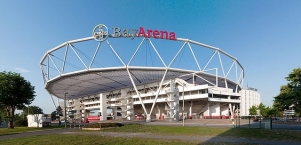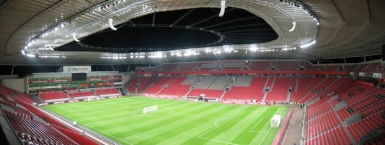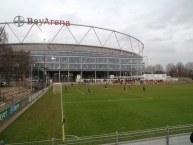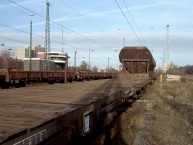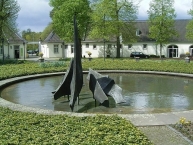Panorama-Radweg Balkantrasse
Aktionen
![]()
Bitte warten - Kartendaten werden geladen
Erstellt am 21.11.2013,
zuletzt geändert von biroto-Redaktion am 02.11.2023
Aktionen
Strecken-Merkmale
Gesamtlänge in km
51
Informationen zu Rechten an den GPS-Track-Daten | |
|---|---|
Rechte-Inhaber | OpenStreetMap and Contributors + biroto-Redaktion (biroto.eu) |
Rechte-Ausprägung / Lizenz | Enthält Daten von OpenStreetMap, die hier unter der Open Database License(ODbL) verfügbar gemacht werden |
Link zur Rechtebeschreibung | |
gpx-Datei übernommen aus | |
gpx-Datei hochgeladen | durch biroto-Redaktion am 02.11.2023
|
Gesamtzahl Trackpoints
882
Trackpoint-Dichte per km
17
Endorte
Start
Leverkusen, NW, DE (41 m NHN)
Ziel
Wuppertal, NW, DE (192 m NHN)
Charakter
Aus der Hügellandschaft des Bergischen zur Tiefebene des Rheins auf der Balkantrasse. Der Name erinnert an den »Balkanexpress« – so wurde die ehemalige Bahnlinie zwischen Leverkusen-Opladen und Remscheid-Lennep im Volksmund genannt.
Der Bahnhof Remscheid-Lennep liegt am Rande des historischen Stadtkerns mit seinem nahezu kreisrunden mittelalterlichen Grundriss und denkmalgeschützten Häusern. Für die Wissenshungrigen lohnt sich ein Abstecher in das Deutsche Röntgenmuseum.
Auf der ehemaligen Bahntrasse geht es ohne große Steigungen und verkehrsfrei entspannt durch die Landschaft – städtisches Leben und ländliches Idyll wechseln sich ab. Nur in Wermelskirchen führt die Strecke auf verkehrsarmen Straßen mitten durch den Ortskern.
Unterwegs auf der rund 19 Kilometer langen Strecke erinnern Meilensteine an die Bahn-Vergangenheit, Rastplätze und Gastronomie gibt es an vielen Orten.
Informationen zu Urheber-Rechten | |
|---|---|
Rechte-Ausprägung / Lizenz | © Alle Rechte vorbehalten. |
Text(e) übernommen von: |
Rechte-Inhaber: Bergische Entwicklungsagentur GmbH, Erlaubnis erhalten am 27.11.2013. |
übernommen / bearbeitet am | 27.11.2013 - 02.11.2023
|
übernommen / bearbeitet durch |
|
Wegweisung
Das gesamte Panorama-Radwege-System ist komplett beschildert. |
|
Informations-Quellen
Portale:
- Offizielles Portal des Panorama-Radweges
Bücher:
- Esterbauer bikeline: Mit dem Fahrrad über Panoramawege im Bergischen Land. Die 11 schönsten Höhenwege zwischen Wupper und Sieg
- ADFC-Radausflugsführer Bergische Bahntrassen 1:50.000 praktische Spiralbindung, reiß- und wetterfest, GPS-Tracks Download: Mit Bergischem Panorama-Radweg, Niederbergbahn und Balkantrasse
- Esterbauer bikeline: Flüsse und Bahntrassen Bergisches Land
Siegtal, Lenne, Ruhr-Sieg & Panorama-Radwege, 1:50.000. 608 km, wetterfest/reißfest
Anschluss-Radwege
- bei Rheinberg
- Rheinradweg (D8)
- EuroVelo: Rheinradweg (EV15)
- bei Lennep Bergischer Panorama-Radweg
Fahrradfreundliche Unterkünfte, Sehenswertes und Infrastruktur
Name u. Anschrift
Breite / Länge
Tel.
Fax.
Mobile
Art d. Unterkunft
Radler-freund-lichkeit
Strecken-km
km zur Strecke
Höhe
0 km
2,9 km
37 m
3 km
2,7 km
33 m
Informationen zu Urheber-Rechten | |
|---|---|
Rechte-Inhaber | |
Rechte-Ausprägung / Lizenz | by-sa: CREATIVE COMMONS Namensnennung, Weitergabe unter gleichen Bedingungen |
Link zur Rechtebeschreibung | |
Bild übernommen aus | |
Bild hochgeladen | durch biroto-Redaktion am 28.12.2013
|
Informationen zu Urheber-Rechten | |
|---|---|
Rechte-Inhaber | Steffen Grocholl |
Rechte-Ausprägung / Lizenz | cc0: Public Domain keine Rechte vorbehalten |
Link zur Rechtebeschreibung | |
Bild übernommen aus | |
Bild hochgeladen | durch biroto-Redaktion am 28.12.2013
|
Informationen zu Urheber-Rechten | |
|---|---|
Rechte-Inhaber | |
Rechte-Ausprägung / Lizenz | by-sa: CREATIVE COMMONS Namensnennung, Weitergabe unter gleichen Bedingungen |
Link zur Rechtebeschreibung | |
Bild übernommen aus | commons.wikimedia.org/wiki/File:Ulrich-Haberland-Stadion_2013-12-08_main_stand.JPG |
Bild hochgeladen | durch biroto-Redaktion am 28.12.2013
|
Die BayArena (1956 bis 1998 Ulrich-Haberland-Stadion) ist ein Fußballstadion in Leverkusen , welches der Bayer 04 Immobilien GmbH gehört, und in dem der Fußball-Klub Bayer 04 Leverkusen
seine Heimspiele austrägt. Sie wird von der Bayer 04 Fußball GmbH, Bayer Gastronomie und der Lindner Hotel AG vermarktet. Durch viele Innovationen und Projekte in den 1990er Jahren war sie einer der Wegbegründer für die modernen europäischen Fußballstadien des neuen Jahrtausends und als das „Schmuckkästchen der Liga“ bekannt.
Die BayArena wurde als multifunktionaler Komplex errichtet und beinhaltet neben Tagungsräumen auch einen offiziellen Fanshop des Vereins. Des Weiteren war die BayArena das erste Stadion Europas mit einem McDonald’s-Restaurant und einem Vier-Sterne-Hotel der Lindner-Gruppe mit 200 Betten. Das Hotel hinter der Nordtribüne besitzt im vierten Stock 120 Logenplätze mit freiem Blick auf den Stadioninnenraum. Die McDonald’s-Filiale ist im Zuge des Umbaus 2008/09 auf die andere Straßenseite gezogen und nun nicht mehr direkter Bestandteil des Stadions.
Mit einem Zuschauervermögen von 30.210 Plätzen ist es eines der kleineren Stadien der Fußball-Bundesliga, resultierend aus einer Auflage für die maximale Gesamtkapazität aufgrund des Standorts in der Nähe von Wohngebieten. Außerdem gibt es noch zehn VIP-Logen für insgesamt 140 Personen mit Tiefgaragen-Parkplätzen. Eine VIP-Loge kostet ca. 10.000 Euro und zusätzliche Kosten für Jahreskarten im Tribünen-Innenraum belaufen sich auf jeweils 1800 Euro pro Person. Mit über 19.000 Saisonkarten sind fast zwei Drittel der Zuschauer Jahreskarteninhaber. Durch die nur 2000 Heimstehplätze hat die BayArena den kleinsten Anteil an günstigen Fanbereichen der Bundesliga und positioniert sich so im Mittel- und Hochpreisbereich.
Informationen zu Urheber-Rechten | |
|---|---|
Rechte-Ausprägung / Lizenz | by-sa: CREATIVE COMMONS Namensnennung, Weitergabe unter gleichen Bedingungen |
Link zur Rechtebeschreibung | |
Text(e) übernommen von: |
Seite „BayArena“. In: Wikipedia, Die freie Enzyklopädie. Bearbeitungsstand: 22. Dezember 2013, 15:16 UTC. URL: http://de.wikipedia.org/w/index.php?title=BayArena&oldid=125687495 (Abgerufen: 27. Dezember 2013, 15:58 UTC) |
übernommen / bearbeitet am | 27.12.2013 - 28.12.2013
|
übernommen / bearbeitet durch |
|
6 km
0,5 km
Informationen zu Urheber-Rechten | |
|---|---|
Rechte-Inhaber | |
Rechte-Ausprägung / Lizenz | by-sa: CREATIVE COMMONS Namensnennung, Weitergabe unter gleichen Bedingungen |
Link zur Rechtebeschreibung | |
Bild hochgeladen | durch InduKult am 04.12.2015
|
Ausgangs- bzw. Zielpunkt für Touren auf der Balkantrasse. Evtl. Rückfahr nach Remscheid-Lennep mit RB48 und S7 via Solingen Hbf. In der Nähe das große ehemalige Ausbesserungswerk, zur Zeit Umbau zur "Bahnstadt".
Informationen zu Urheber-Rechten | |
|---|---|
Rechte-Ausprägung / Lizenz | by-sa: CREATIVE COMMONS Namensnennung, Weitergabe unter gleichen Bedingungen |
Link zur Rechtebeschreibung | |
übernommen / bearbeitet am | 04.12.2015
|
übernommen / bearbeitet durch |
|
8 km
4,0 km
46 m
Informationen zu Urheber-Rechten | |
|---|---|
Rechte-Inhaber | |
Rechte-Ausprägung / Lizenz | by: CREATIVE COMMONS Namensnennung |
Link zur Rechtebeschreibung | |
Bild übernommen aus | commons.wikimedia.org/wiki/File:Schloss_Morsborich_Panorama.jpg |
Bild hochgeladen | durch biroto-Redaktion am 29.12.2013
|
Informationen zu Urheber-Rechten | |
|---|---|
Rechte-Inhaber | |
Rechte-Ausprägung / Lizenz | by-sa: CREATIVE COMMONS Namensnennung, Weitergabe unter gleichen Bedingungen |
Link zur Rechtebeschreibung | |
Bild übernommen aus | commons.wikimedia.org/wiki/File:Leverkusen_-_Schloss_Morsbroich_21_ies.jpg |
Bild hochgeladen | durch biroto-Redaktion am 29.12.2013
|
Das Schloss Morsbroich [ˈmoɐ̯sbʀoːx] im Leverkusener Stadtteil Alkenrath
ist eine ehemalige Kommende des Deutschen Ordens. Seit 1951 ist im Schloss das Städtische Museum für moderne Kunst beheimatet.
Ignaz Felix Freiherr von Roll ließ 1757 das „gantz ruinöse“ frühere Gebäude niederlegen und an seiner Stelle 1775 ein Schloss als „Maison de plaisance“ im Stil des Rokoko errichten. Als Vorbild diente das Jagdschloss Falkenlust in Brühl. Etwa zur gleichen Zeit wurde auch ein dazugehöriger Englischer Landschaftsgarten angelegt.
Im Zuge der Säkularisation wurde der Besitz des Deutschen Ordens 1803 verstaatlicht und ging 1806 in französischen Besitz über, als Joachim Murat, ein SchwagerNapoléons, von diesem zum Herzog von Kleve und Berg ernannt worden war.
Nachdem das Rheinland als Folge des Wiener Kongresses Teil des Königreichs Preußen geworden war, erwarb 1817/18 der Kölner Bankier Abraham Schaaffhausen das Schloss einschließlich der zugehörigen Grafschaft Morsbroich von Agar. Nach dem Tod Schaaffhausens am 13. Januar 1824 verblieb der Besitz unabgeteilt in dessen Nachlass. 1857 gelangte die gesamte Herrschaft an Friedrich von Diergardt. Diergardt errichtete 1859 eine Stiftung zur Umwandlung der Grafschaft Morsbroich in die Familienfideikommisse Morsbroich und Dünnwald, in denen sie bis zum Ende des Kaiserreichs 1918 verblieben. Seine Familie ließ das Gebäude von 1885 bis 1887 um zwei Seitenflügel nach Plänen des Kölner Architekten Hermann Otto Pflaume erweitern.
Nach dem Zweiten Weltkrieg mietete die Stadt Leverkusen das stark beschädigte Gebäude im Jahr 1948. Nachdem Pläne zur Errichtung eines Alters- oder Kinderheimes im Schloss verworfen worden waren, wurde dort 1951 auf eine Initiative von Bertha Middelhauve hin ein Museum eröffnet. Im Jahr 1974 beschloss der Leverkusener Stadtrat den Kauf des Besitzes. Nach mehrjährigen Umbau- und Renovierungsarbeiten öffnete das Museum im Oktober 1985 erneut seine Pforten für die Öffentlichkeit mit dem städtischen Museum für moderne Kunst, das bis heute dort besteht. Das Museum ist spezialisiert auf analytische Malerei, den Nouveau Réalisme, die Op-Art, die kinetische Kunst sowie die Monochromie(mit beispielsweise Yves Klein oder Piero Manzoni).
Darüber hinaus ist das Schloss Repräsentationsfläche der Stadt Leverkusen und bietet die Möglichkeit der Hochzeit im Spiegelsaal.
Informationen zu Urheber-Rechten | |
|---|---|
Rechte-Ausprägung / Lizenz | by-sa: CREATIVE COMMONS Namensnennung, Weitergabe unter gleichen Bedingungen |
Link zur Rechtebeschreibung | |
Text(e) übernommen von: |
Seite „Schloss Morsbroich“. In: Wikipedia, Die freie Enzyklopädie. Bearbeitungsstand: 10. Juni 2013, 21:30 UTC. URL: http://de.wikipedia.org/w/index.php?title=Schloss_Morsbroich&oldid=119425831 (Abgerufen: 29. Dezember 2013, 18:13 UTC) |
übernommen / bearbeitet am | 29.12.2013
|
übernommen / bearbeitet durch |
|
Öffnungszeiten
Donnerstag 11 bis 21 Uhr (außer feiertags, dann nur bis 17 Uhr)
Dienstag, Mittwoch, Freitag bis Sonntag 11 bis 17 Uhr
Öffentliche Führung jeden Sonntag 15:00 Uhr
11 km
0,4 km
132 m
![]()


